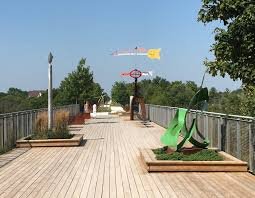Discover the Rich History of
Our Elevated Park
It has stood at the western edge of the city since 1929, a recognized engineering marvel of its era which, at its peak carried some 50 trains each day, both freight and passenger.
1872
Canada Southern Railway Kettle Creek Bridge
The CSR single-track, timber-trestle over Kettle Creek at St. Thomas was completed in February, 1872. The trestle was made of framed timber, carried a single track, and was 28m (92 feet) high and 416 m (1,365 feet) long. It consisted of 14 Howe truss deck spans supported on timber bents. The longest span over Kettle Creek was 13.7 m (45 feet).
1883
Michigan Central Railroad Kettle Creek Bridge
In 1883, the year after the CSR was leased to the MCR, the timber trestle was replaced with a double-tracked, metal structure 425 m (1,395 feet) long and 28.3m (93 feet) above the creek bed. The bridge deck was supported on metal trestle bents that formed towers 9.1 m (30 feet) long at their tops (in the direction of the rail). Between the towers was a clear span of 13.7 m (45 feet). The deck was constructed of plate girders which carried an unballasted track structure. The viaduct was the same length as the previous timber trestle. Although the bridge was double-tracked, trains travelling in opposite directions were prohibited from meeting each other on the structure.
1928
Michigan Central Railroad Bridge
The design for a replacement structure over Kettle Creek was underway in 1928. The final planwas selected to involved minimal disturbance to rail traffic during the rebuilding. The general contract for the work was awarded on April 25, 1929. The entire project cost $689,000 (at the time). The entire work, except for field painting and the hand railings was completed on January 3, 1930. The steel was fabricated by the Canadian Bridge Company in Walkerville, Ontario.
As built, the structure consisted of 13 piers however, since the abutments were also counted as piers, the bridge was described as having 15 piers. The piers were constructed of concrete except for the centre one which was a steel-truss. The main, eight spans were 22.9 m (75 feet) and provided a clear span of 18.3 m (60 feet) between the piers. The two piers at each end were shorter and less massive, being built on the slop of the earthworks. The main piers were approximately 27.4 m (90 feet) tall except for pier five which was located within Kettle Creek and was 33.2 m (109 feet).
(Taken from Heritage Impact Assessment by Golder Associates)
2013
ON TRACK ST. THOMAS BUYS THE MCR KETTLE CREEK BRIDGE
In 2013, On Track St. Thomas buys the MCR Bridge plus 4 km of former rail corridor. On Track is a non-profit dedicated to preserving and promoting the railway heritage of the community. Planning and fundraising for the St. Thomas Elevated Park begins.
2017
ST. THOMAS ELEVATED PARK OPENS TO THE PUBLIC
After years of planning, the eastern third of the bridge is opened in 2017 as Canada’s first Elevated Park, with safety railings, public art, plantings and seating areas. The trail from King St. to the Elevated Park is fully accessible.
The Elevated Park is opened “End-To-End” with the completion of the boardwalk in 2019, additional safety railings, a fully accessible sidewalk, plantings and seating areas.
In 2020, The Western Trail opens, completing the trail from King St. in St. Thomas to Lyle Rd in Southwold a total of 4 km.
In 2024, work begins on The Arboretum Line, an ambitious plan to plant native trees along the Western Trail
2025
ELEVATED PARK JOINS RAILWORKS
The Elevated Park joins The Railworks Coalition, an umbrella organization for the railway heritage assets in St. Thomas, joining the CASO Station and the Elgin County Railway Museum.





